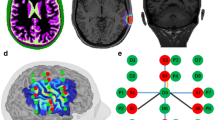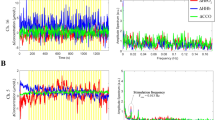Abstract
Purpose
Because the brain can divide into many separate regions structurally and these regions don’t exist independently in terms of their function, there are some tendencies between these regions.
Methods
This functional connectivity has been analyzed using functional magnetic resonance imaging (fMRI), but in recent, diffuse optical tomography (DOT) has started to analyze these connectivity. In our experiment, we measured the coactivation in brain regions in response to sensory stimulation using CW-DOT.
Results
Concentration changes in oxyhemoglobin and deoxyhemoglobin was calculated using reconstructed absorption coefficients at each nodes in finiteelement mesh. Then these time-series node data were mapped on our rat brain MR image. In addition, we analyzed coactivation by calculating correlation coefficients between time-series node data and standard response pattern of two parameters.
Conclusions
We ascertained that some brain regions were coactivated under sensory stimulation.
Similar content being viewed by others
References
Ogawa S, Lee T, Kay A, Tank D. Brain magnetic resonance imaging with contrast dependent on blood oxygenation. Natl Acad Sci U S A. 1990; 87(24):9868–72.
Biswal B, Yetkin FZ, Haughton VM, Hyde JS. Functional connectivity in the motor cortex of resting human brain using echo-planar MRI. Magn Reson Med. 1995; 34(4):537–41.
Huettel SA, Güzeldere G, McCarthy G. Dissociating the neural mechanisms of visual attention in change detection using functional MRI. J Cogn Neurosci. 2001; 13(7):1006–18.
Molavi B, May L, Gervain J, Carreiras M, Werker JF, Dumont GA. Analyzing the resting state functional connectivity in the human language system using near infrared spectroscopy. Front Hum Neurosci. 2013; doi: 10.3389/fnhum.2013.00921.
White BR, Snyder AZ, Cohen AL, Petersen SE, Raichle ME, Schlaggar BL, Culver JP. Resting-state functional connectivity in the human brain revealed with diffuse optical tomography. Neuroimage. 2009; 47(1):148–56.
Lee S, Lee HJ, Im C, Shin HC, Koh D, Kim BM. Simultaneous measurement of hemodynamic and neuronal activities using near-infrared spectroscopy and single-unit recording. J Kor Phys Soc. 2011; 58:1697–702.
Kober S, Wood G, Kurzmann J, Friedrich E, Stangl M, Wippel T, Väljamäe A, Neuper C. Near-infrared spectroscopy based neurofeedback training increases specific motor imagery related cortical activation compared to sham feedback. Biol Psychol. 2014; 95:21–30.
Dehghani H, Eames ME, Yalavarthy PK, Davis SC, Srinivasan S, Carpenter CM, Pogue BW, Paulsen KD. Near infrared optical tomography using NIRFAST: Algorithm for numerical model and image reconstruction. Commun Numer Methods Eng. 2009; 25(6):711–32.
White BR. Developing high-density diffuse optical tomography for neuroimaging. Ph.D. Thesis; Wasington University; U S A; 20–2.
Arridge SR. Optical tomography in medical imaging. Inverse Problems. 1999; 15(2): doi:10.1088/0266-5611/15/2/022
Li A, Zhang Q, Culver JP, Miller EL, Boas DA. Reconstructing chromosphere concentration images directly by continuouswave diffuse optical tomography. Opt Lett. 2004; 29(3):256–8.
Paxinos G, Watson C. The rat brain in stereotaxic coordinates. London, U K: Academic Press; 20–6.
Malonek D, Grinvald A. Interactions between electrical activity and cortical microcirculation revealed by imaging spectroscopy: implications for functional brain mapping. Science. 1996; 272(5261):551–4.
Patterson MS, Andersson-Engels S, Wilson BC, Osei EK. Absorption spectroscopy in tissue-simulating materials: a theoretical and experimental study of photon paths. Appl Opt. 1995; 34(1):22–30.
Huettel SA, Song AW, McCarthy G. Functional magnetic resonance imaging. Sunderland MA: Sinauer Associates: 20–4.
Author information
Authors and Affiliations
Corresponding authors
Rights and permissions
About this article
Cite this article
Kim, SW., Paik, SH., Song, KI. et al. Functional connectivity change of the rat brain in response to sensory stimuli using functional near-infrared brain imaging. Biomed. Eng. Lett. 4, 370–377 (2014). https://doi.org/10.1007/s13534-014-0166-7
Received:
Accepted:
Published:
Issue Date:
DOI: https://doi.org/10.1007/s13534-014-0166-7




